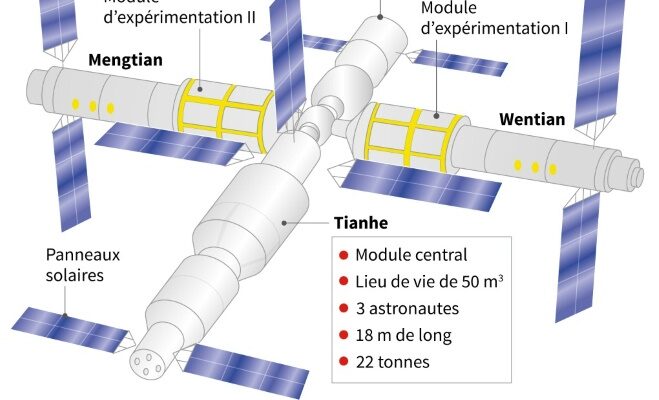Liftoff of the Long March-2F rocket to the Tiangong space station on May 30, 2023 in Jiuguan, northwest China (AFP/Hector RETAMAL)
China sent three new astronauts to its Tiangong space station on Tuesday, including a civilian for the first time, with the aim of strengthening its knowledge of manned flight against the Americans and Russians.
A valuable experience for the Asian giant, which reaffirmed on Monday that it wanted to send a Chinese to the Moon by 2030, the main objective of a space program which has been progressing steadily for several decades.
The trio of the Shenzhou-16 mission took off aboard a Long March 2F rocket at 09:31 local time (0131 GMT) from the Jiuquan launch center in the Gobi desert (northwest), according to journalists from the AFP on the spot.
The launch was a “total success” and the “astronauts are in good shape”, said Zou Lipeng, director of the launch center.
Dozens of space program employees, many of whom live year-round on the massive space site, watched the liftoff and took selfies with the towering rocket in the background.
Children were playing while waiting for the machine to leave when some were waving Chinese flags, perched on the shoulders of their parents.
Spectators let out a big “wow” of wonder and shouted “good luck”, waving at the rocket which took off, letting out a cloud of ocher smoke.
Mission commander, veteran Jing Haipeng (56), on his fourth space flight, is accompanied by engineer Zhu Yangzhu (36) and Gui Haichao (36), professor and first Chinese civilian in space.
A specialist in science and space engineering, the latter will be more particularly responsible for the experiments on board the station. He does not come from the armed forces as was always the case until now.
Their stay on Tiangong (“Heavenly Palace”) is to last six months.
There they will find their three colleagues from the previous mission, Shenzhou-15, who have already been there for six months and who will come back down to Earth in a few days.
“What is significant” in this mission is precisely “that there is nothing significant” because the Chinese manned program is now entering a longer period, underlines Jonathan McDowell, astronomer at the Harvard-Smithsonian Center for Astrophysics, USA.
– Delay to catch up –
China now intends to “accumulate experience in manned spaceflight”, an “important” objective and which “does not involve new spectacular steps all the time”, he notes to AFP.

From left: Chinese astronauts Gui Haichao, Zhu Yangzhu and Jing Haipeng greet the public before their takeoff to the Tiangong space station on May 30, 2023 in Jiuquan, northwest China (AFP/Hector RETAMAL)
This is mainly for the astronauts to ensure crew rotations, a permanent occupation of Tiangong, maintenance and research work, as well as a slow expansion of the station’s capacities, explains Mr. McDowell.
China has some catching up to do in this regard, as it only sent its first human into space in 2003 – a long time after the Soviets and the Americans in 1961.
Tiangong, whose construction is now complete, has had its final T-shaped shape for a few months. Similar in size to the former Russian-Soviet Mir station, it is however much smaller than the International Space Station (ISS).
Also known as CSS (for “Chinese Space Station” in English), it must remain in Earth orbit for at least 10 years.
Tiangong was supplied with drinking water, clothing, food and fuel in May ahead of Shenzhou-16.
China was partly pushed to build its own station due to the refusal of the United States to allow it to participate in the ISS. An American law prohibits almost any collaboration between American and Chinese space authorities.
– Objective moon –
The Asian giant however reiterated on Monday its desire to carry out international cooperation around Tiangong, in particular for the realization of experiments.

The Chinese space station Tiangong (AFP/Laurence CHU)
“I am extremely eager and eager to see foreign astronauts take part in missions in the Chinese space station,” also told a press conference Lin Xiqiang, the spokesperson and deputy director of the China Flight Agency. manned space (CMSA in English).
In the longer term, he also reaffirmed the country’s desire “to achieve the first landing of a Chinese on the Moon before 2030” in order in particular to carry out “scientific observations” there.
China has already invested billions of euros in its space program.
In 2019, the country landed a device on the far side of the Moon, a world first. In 2020, he brought back samples from the Moon and finalized Beidou, his satellite navigation system.
In 2021, China landed a small robot on Mars.
The Asian giant now plans to launch two manned space missions each year, CMSA said on Monday.
The next will be Shenzhou-17, which is expected to launch in October.
© 2023 AFP
Did you like this article ? Share it with your friends with the buttons below.




